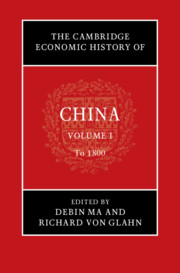Book contents
- The Cambridge Economic History of China
- The Cambridge Economic History of China
- The Cambridge Economic History of China
- Copyright page
- Contents
- Figures
- Maps
- Tables
- Contributors to Volume I
- Acknowledgments
- Note on Citations
- Introduction to Volume I
- Part I Before 1000
- Interlude
- Part II 1000 to 1800
- Bibliography of Primary Works Cited
- Index
Introduction to Volume I
Published online by Cambridge University Press: 07 February 2022
- The Cambridge Economic History of China
- The Cambridge Economic History of China
- The Cambridge Economic History of China
- Copyright page
- Contents
- Figures
- Maps
- Tables
- Contributors to Volume I
- Acknowledgments
- Note on Citations
- Introduction to Volume I
- Part I Before 1000
- Interlude
- Part II 1000 to 1800
- Bibliography of Primary Works Cited
- Index
Summary
China’s rise as the world’s second-largest economy surely is the most dramatic development in the global economy since the year 2000. But China’s prominence in the global economy is hardly new. Since 500 bce, a burgeoning market economy and the establishment of an enduring imperial state fostered precocious economic growth. Moreover, contrary to the view that China’s economy withered under the dual constraints of Western colonialism and Chinese tradition after 1800, recent scholarship has identified the onset of modern economic growth in response to new incentive structures, investment opportunities, ideas, and technology, laying the foundation for the post-1978 economic miracle. China’s combination of market-led growth under the firm hand of the state has produced a model of economic development that challenges conventional theories of capitalism and economic growth. The spectacular growth of the contemporary Chinese economy also spurred deeper investigation into the Chinese economy – long a neglected field of study, at least in the Western academy. Scholarship on Chinese economic history has now developed to the stage where a Cambridge History devoted to the subject is appropriate and feasible.
- Type
- Chapter
- Information
- The Cambridge Economic History of China , pp. 1 - 12Publisher: Cambridge University PressPrint publication year: 2022

